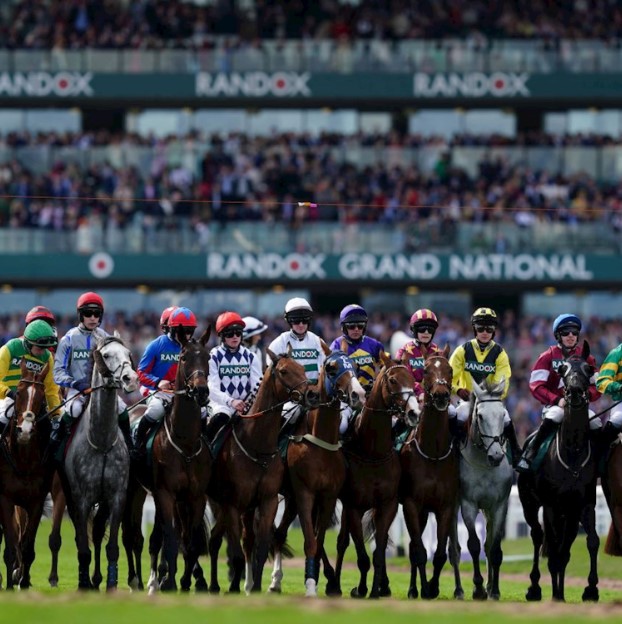
Grand National is a household name not only in its birthplace, Britain, but also in the worldwide horse racing community. Every year, the far-famed event amasses hundreds of millions of views and wagers online. We’ve gathered a bunch of engaging facts about the race for a curious read.
What Is the Grand National?
The Grand National is an annual steeplechase, a horse racing competition with fences and ditches all over the distance. Initially devised as an amateur contest for gentlemen, the race has transformed into more of a professional sport with thorough preparation and serious investment.
The Grand National UK competition is open to out-of-country contenders as well as male and female riders. Participants wear jockey silks of different colors to make them easier to distinguish. Starting in 2024, the number of competitors is 34, 6 fewer than in previous years.
Each horse running must cover about 7 kilometers of a turf track and jump 30 fences overall, which makes the steeplechase one of the most challenging. The race is a handicap, meaning all runners carry weights allocated well in advance according to their abilities to even the odds.
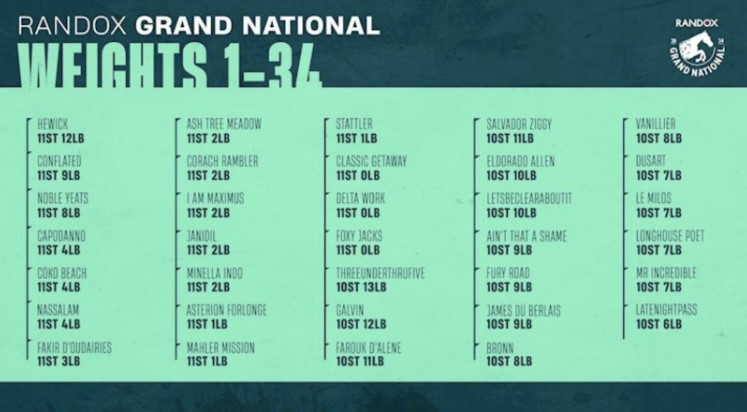
The steeplechase is also one of the most prized, with an enormous purse of £1,000,000. And, of course, it’s a real treat for sports bettors. The National is massively bet on inside and outside the UK, not only by the sport betting pros but also by neophytes and even complete ignoramuses.
The event’s legend is Red Rum, an unbeatable three-time race champion with an extraordinary jumping knack. His trainer, Ginger McCain, holds 4 wins in total, sharing the record with George Dockeray and Fred Rimell. The competition’s best jockey ever is George Stevens, with 5 wins.
Summarized below are some technicalities and trivia of the celebrated UK-based steeplechase.
| 🏟️Track length and surface | 6.907 km or 4 miles 514 yards on turf |
| 🗓️Event frequency and time | Annually in April |
| 🐴Horses qualified | Stallions and mares of at least 7 years old |
| 🐎Oldest horse to win | Peter Simple, won at the age of 15 |
| 🏇Youngest jockey to win | Bruce Hobbs, won at the age of 17 |
| 🌍First international winner | Count Karl Kinsky of Austria on board Zoedone |
| 👩First female winner | Rachael Blackmore on board Minella Times |
| ⏱️Fastest winning time | 8:47.80, achieved by Mr Frisk in 1990 |
| 🥇Latest champion | I Am Maximus, French-bred, Irish-trained and ridden |
When Did the Grand National Begin?
The Grand National horse race is steadily moving towards its 200th anniversary. Inaugurated in February 1839, the event has a longer history, which is still a matter of heated debate among historians. The following are a few milestones signifying pivotal points in the National’s story:
- February 7, 1829: The foundation for the future racecourse was laid.
- February 26, 1839: Jem Mason and his horse Lottery won the first race.
- March 1, 1843: The steeplechase took on a handicap format.
- March 30, 1928: Tipperary Tim won the competition at 100/1 odds.
- March 26, 1955: The Irish trainer Vincent O’Brien scored a hat-trick.
- April 2, 1977: Red Rum set a record, winning the race for the third time.
- April 3, 1993: The National was first and once annulled due to a false start.
- April 5, 2014: The event’s prize fund reached £1 million for the first time.
- April 15, 2023: The contest was disrupted due to animal activists’ protests.
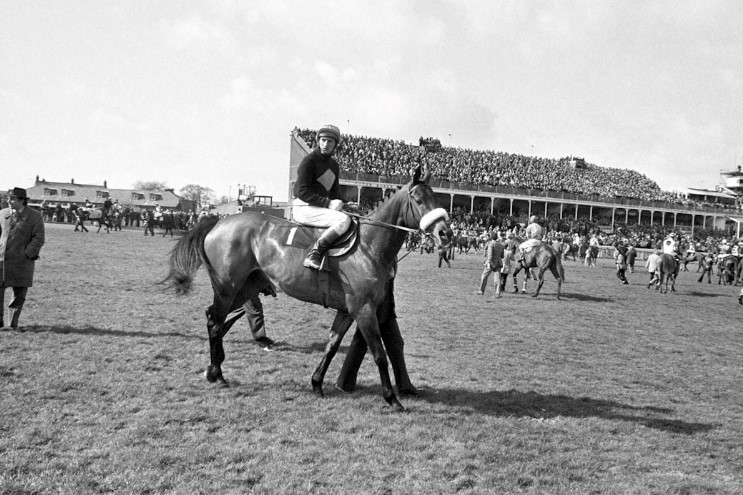
In the 1953 edition of the steeplechase, Vincent O’Brien scored his first victory as a trainer with Early Mist. Before the start, he advised the owner, Joe Griffin, to be generous while betting on his horse. As a result, Griffin snatched an astronomical £100,000 when Early Mist came in first.
Throughout its history, the National has produced a slew of happy punters. A good portion of them wagered at 1xBet, a top spot for betting on sport events related to horseback riding and far beyond. Returns are impressive from wagers made on horse racing betting odds with 1xBet.
Where Is the Grand National Held?
In 1829, a piece of land near Liverpool was turned into what we know now as Aintree Racecourse, a venue for the Grand National. The venue, which is also used for motor racing, golf, and music concerts, was named after the village of Aintree in Merseyside, England.
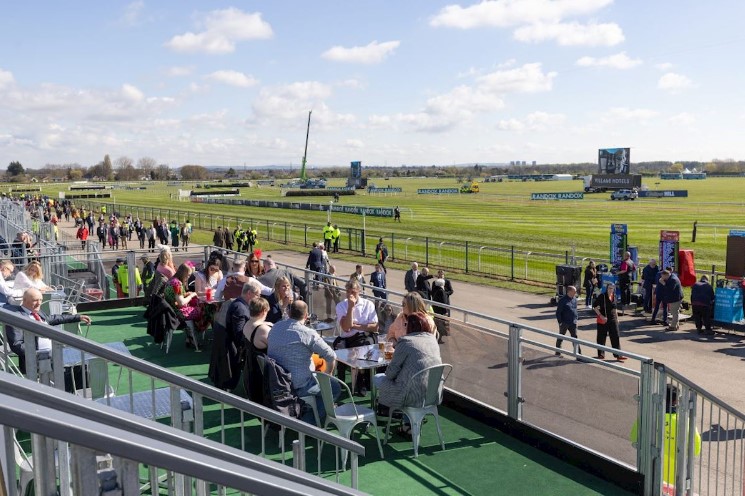
The site for the grand racecourse is a left-handed turf track with 16 fences. Originally made of thorns, the fences are now crafted from spruce, which makes them more flexible and less harmful. They vary by size and challenge, and some are even nicknamed, including the likes of:
- The Chair: 1.57 m in height, with a 1.83 m wide ditch in the front.
- Becher’s Brook: 1.52 m in height, with landing lower than takeoff.
- Valentine’s Brook: 1.52 m in height, with a 1.68 brook.
- Canal Turn: 1.52 m in height.
- Foinavon: 1.37 m in height.
- Water Jump: 0.76 m in height.
When running the race, contenders overcome all 16 obstacles on the first circuit and 14 on the second, avoiding fence 15 and fence 16, that is, The Chair and the Water Jump, respectively. Thus, participants cover the United Kingdom’s longest distance for horse racing over jumps.
Aintree Racecourse has been hosting the event since 1839, interrupted only by periods of war. During World War I and World War II, that is, from 1916 to 1918 and from 1941 to 1945, the venue did not hold the race and was used for the needs of the British military departments.
What Happens on the Different Days of the Grand National?
Well, yes, fortunately for visitors, it’s not a one-day event. How long is the Grand National? It’s three unforgettable days. With its own theme, activities, and unique air, each day is a phenomenal experience and undoubtedly worth a see. Below is the event’s schedule by day.
Day 1: Opening Day
This is where the grand party begins. The opener introduces attendees to frontmost runners and riders demonstrating their outstanding skills in a series of races, including two steeplechases and two hurdle races of Grade I. So, non-stop suspense and excitement are guaranteed.
The sport apart, the kickoff day offers everything you can expect at a first-class festival. It immerses everyone present in the atmosphere of joy and fun thanks to its fascinating shows and live music performances. And, of course, there’s no end to delicious food and drinks.
Day 2: Ladies Day
Ladies First is the true motto of day two. On this day, the venue turns into a runway on which the ladies in attendance walk in their most chic outfits. Ladies Day is renowned for iconic looks by its glamorous visitors, the best of whom are given the Style Awards along with admiring glances.
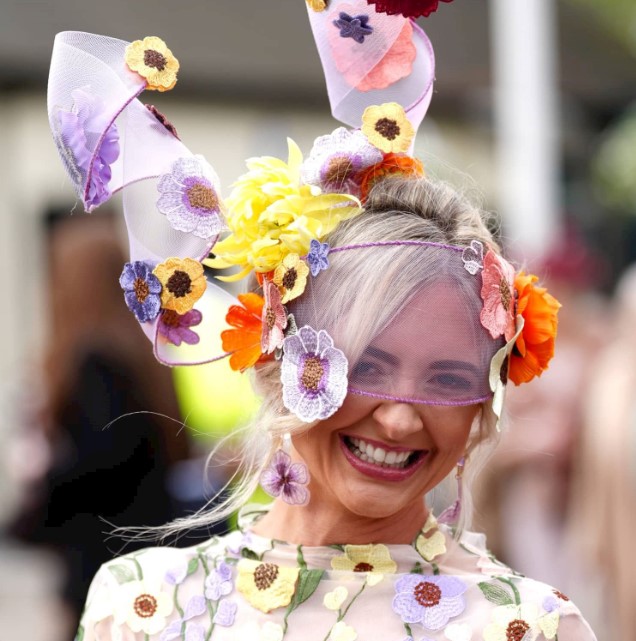
With a premium put on fashion, the National’s second day continues to delight equestrian sports enthusiasts. It features a number of breathtaking contests where novice and expert competitors capture the attention of thousands of attendees by running different distances and obstacles.
Day 3: Grand National Day
The final day is what everyone is here for: the most anticipated steeplechase of the year. On the Grand National Day, the stands are overcrowded, and online views are at their peak. The sought-after competition, both heart-racing and heart-breaking, is an experience like no other.
While waiting for the biggest race and its dramatic outcome, the audience can warm up by cheering on their favorites in a few preceding hurdles. After the main intrigue unfolds and the Grand National winner is crowned, a couple more races are held to wrap up the festival.
Is the Grand National on TV?
One of the world’s greatest horse races has been on TV since 1960, with over 600 million views annually in about 150 countries. After being televised for more than 50 years by the BBC, the event was then broadcast by Channel 4. Since 2017, ITV has been the National’s broadcaster.
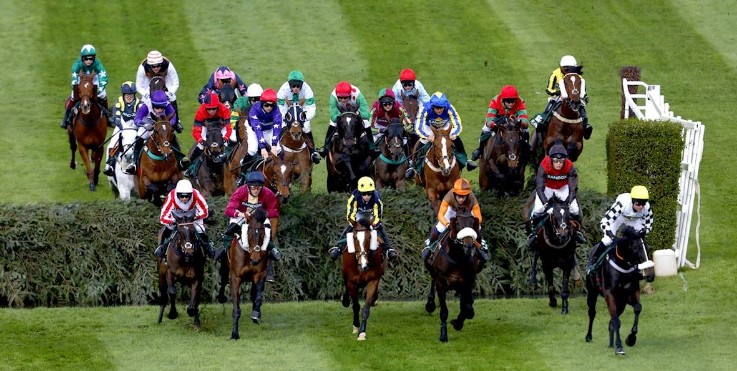
How to Get to the Grand National?
The exact location of the horse racing festival is Aintree Racecourse, Ormskirk Road, Aintree, Liverpool L9 5AS. British and foreign racegoers know the place, as well as the routes to it, by heart. You can get to the racecourse any way you want, choosing among the following means.
| 🚗By car | Take the A59 to Liverpool and follow the signs. |
| 🚌By bus | Pick bus routes 300, 310, and 345 to and from Liverpool. |
| 🚅By train | Use the convenient Merseyrail line to Aintree Station. |
| 🛬By air | Take a flight to Liverpool John Lennon Airport, followed by a 20-minute drive. |
What to Wear to the Grand National?
The Grand National does not officially prescribe what to wear and only recommends that you dress in a way that makes you feel your best. Nevertheless, there are some distinct dress code guidelines, such as a ban on masquerade costumes and sports clothing.
Also, there are unspoken rules that only the regulars know about, like the ones we share below.
What Do Men Wear to the Grand National?
The preferred men’s look is a classic suit, often a three-piece, with smart shoes. A tie or bowtie and a hat are fine additions, albeit optional. You can brighten up the traditional muted palette of your suit with color accents on the shirt, socks, shoes, tie, and pocket square.
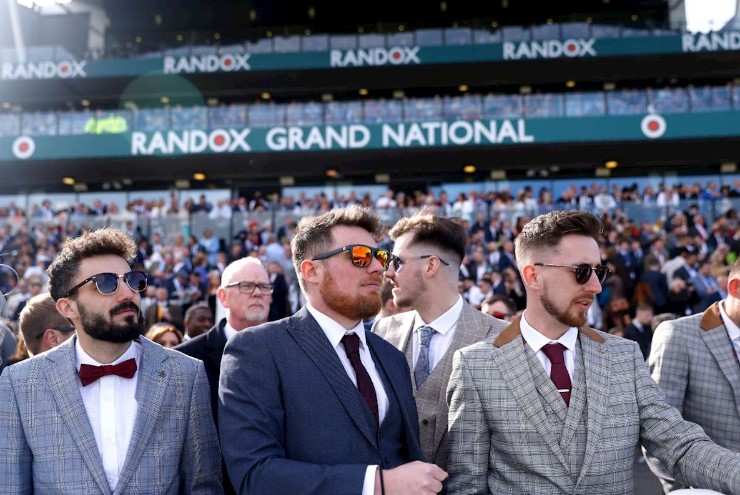
While elegance and style are key, comfort is no less important, so it’s better to opt for materials that keep you warm and comfortable all day long. Finally, as usual, the devil is in the details, so think carefully about the accessories to your attire, such as a watch, belt, braces, and cufflinks.
What Do Women Wear to the Grand National?
Due to the lack of a dress code, ladies can feel free to choose their looks: both classic suits and dresses and less formal co-ords and mini dresses will do. Women are welcome in their best outfits, rich in color and glamor, to have beautiful pictures and qualify for the Style Awards.
The look can be completed by perfectly matched heels, a bag, and a hat, of course. The Grand National is not without women’s headwear striking in its variety and exquisite design. But no matter how stylish your outfit is, it must be weather-appropriate and comfortable to wear.
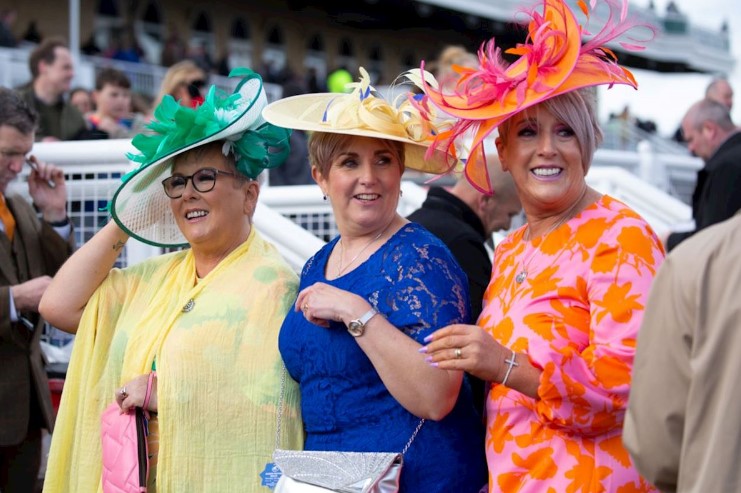
Conclusion
Every year, horse racing fans look forward to April to enjoy the Grand National festival and everything it offers. The epic equestrian event allows you to witness the highest steeplechase achievement and maximize the excitement and financial satisfaction of betting on horse races.
All you need is to take care of a suitable outfit and arrive at Aintree on the appointed day by a convenient route. Or you can simply turn on the broadcast and watch history being made online.